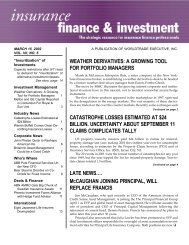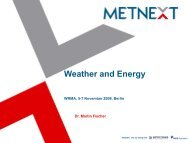Global Weather Sensitivity: A Comparative Study - albertotroccoli.org
Global Weather Sensitivity: A Comparative Study - albertotroccoli.org
Global Weather Sensitivity: A Comparative Study - albertotroccoli.org
- No tags were found...
You also want an ePaper? Increase the reach of your titles
YUMPU automatically turns print PDFs into web optimized ePapers that Google loves.
the United Arab Emirates, Kuwait, and Saudi Arabia, respectively. Norway,<br />
where mining comprises 25% of GDP, also scores highly, ranking 4th in the total<br />
sensitivity scores. As mentioned above, there is some doubt in the accuracy<br />
of Larsen’s elasticity values for the mining sector. Again, however, anecdotal<br />
evidence from the world’s largest mining company, Rio Tinto, suggests that<br />
weather plays a key role in global production.<br />
A few observations stand out from an analysis of the results in Table 1.<br />
First, the correlation between level of economic development and weather sensitivity<br />
is surprisingly weak. A simple r-squared test of sensitivity scores and the<br />
UN Human Development Index returned a value of 0.05, which is too small to<br />
assume any sort of statistically significant correlation. There are a number of<br />
intuitive reasons to believe that economic development would have some impact<br />
on weather sensitivity: poorer countries tend to be more dependent on agriculture<br />
and tourism, sectors that are highly weather sensitive; and less developed<br />
countries could likely have a weaker infrastructure when confronting weather<br />
risks; also, it seems plausible that countries with high degrees of weather variability<br />
would confront more obstacles to developing their economies and would<br />
be generally poorer. But our results do not substantiate these claims.<br />
A second observation is the small but significant impact of corrections on<br />
sensitivity scores. Though most country rankings did not change much with<br />
the inclusion of corrections, some countries moved significantly. Morocco and<br />
Tunisia, the two North African countries included in the study, moved from<br />
49th to 29th and from 52nd to 36th, respectively, when corrections were added.<br />
Other countries highly affected by the inclusion of corrections were Bolivia and<br />
Kazakhstan, which moved from 25th to 19th and from 37th to 27th, respectively.<br />
All of these countries exhibit yield per hectare values far below the country<br />
mean, and therefore correction scores far above the mean. Given the concerted<br />
15











